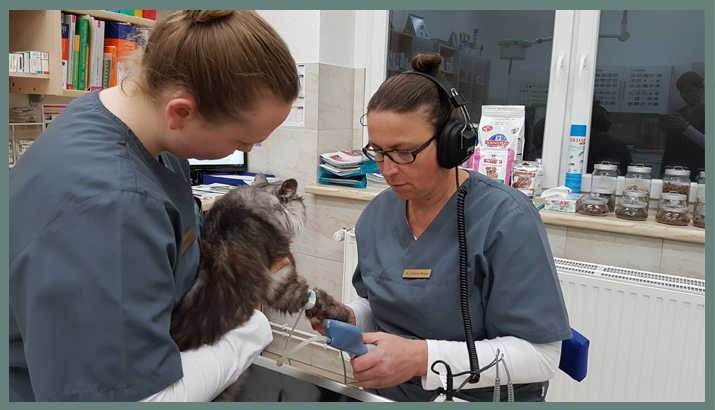
BLUTDRUCKMESSUNG
Auch unsere Hunde und Katzen können unter Bluthochdruck leiden.
Im Verlauf einiger Erkrankungen wie zum Beispiel bei chronischen Nieren- oder Herzleiden, Überfunktion der Schilddrüse (Hyperthyreose), Zuckerkrankheit (Diabetes mellitus) oder anderen endokrinen (inneren) Erkrankungen tritt er gehäuft auf.
Da es sich vorwiegend um Erkrankungen im höheren Lebensalter handelt, sollte eine Blutdruckmessung für den älteren Patienten – vor allem bei der Katze – bei der jährlichen Untersuchung nicht fehlen.
Ein unbehandelter Bluthochdruck zieht Schädigungen an wichtigen Organen nach sich.
- Auge: Durch Netzhautveränderungen und -ablösung kommt es zu Blutungen ins Auge und Blindheit.
- Herz: Am Herzen kommt es zu einer Verdickung der Herzwände in der linken Hauptkammer.
- Niere: Die Nieren werden schwer belastet und es folgt später ein Nierenversagen.
- ZNS: Im zentralen Nervensystem kann es zu Blutungen mit nachfolgendem Anfallsgeschehen, Krämpfen und Schlaganfällen kommen.
Symptome für Bluthochdruck können sehr hinweisend oder auch unspezifisch sein.Auf jeden Fall sollten Sie Ihren Tierarzt aufsuchen wenn Sie Folgendes bei Ihrem Haustier bemerken:
– plötzliches Erblinden
– Erweiterte Pupillen, auch einseitig
– Blutungen im Auge
– Depression
– Krämpfe
– übermäßiges Lautgeben
– Nasenbluten
– Appetitlosigkeit
– Verhaltensänderungen
– Vermehrtes Trinken und Wasserlassen
Wie läuft die Blutdruckmessung ab?
Die Prozedur ist für Ihr Tier vollkommen schmerzlos und dauert ca. 1 Minute, wenn der Patient gut stillhält.
Es wird eine Blutdruckmanschette am linken Vorderbein angelegt und mittels einer Dopplersonde an der Innenfläche der Pfote eine Arterie aufgesucht. Das von ihr ausgehende akustische Signal verschwindet bei Aufpumpen der Manschette und der entsprechende Blutdruck wird auf dem Manometer abgelesen.
Die Behandlung des Bluthochdrucks erfolgt mittels blutdrucksenkenden Medikamenten und sollte in regelmäßigen Abständen kontrolliert werden.
Schützen Sie Ihr Tier vor den Spätfolgen eines Bluthochdrucks!
